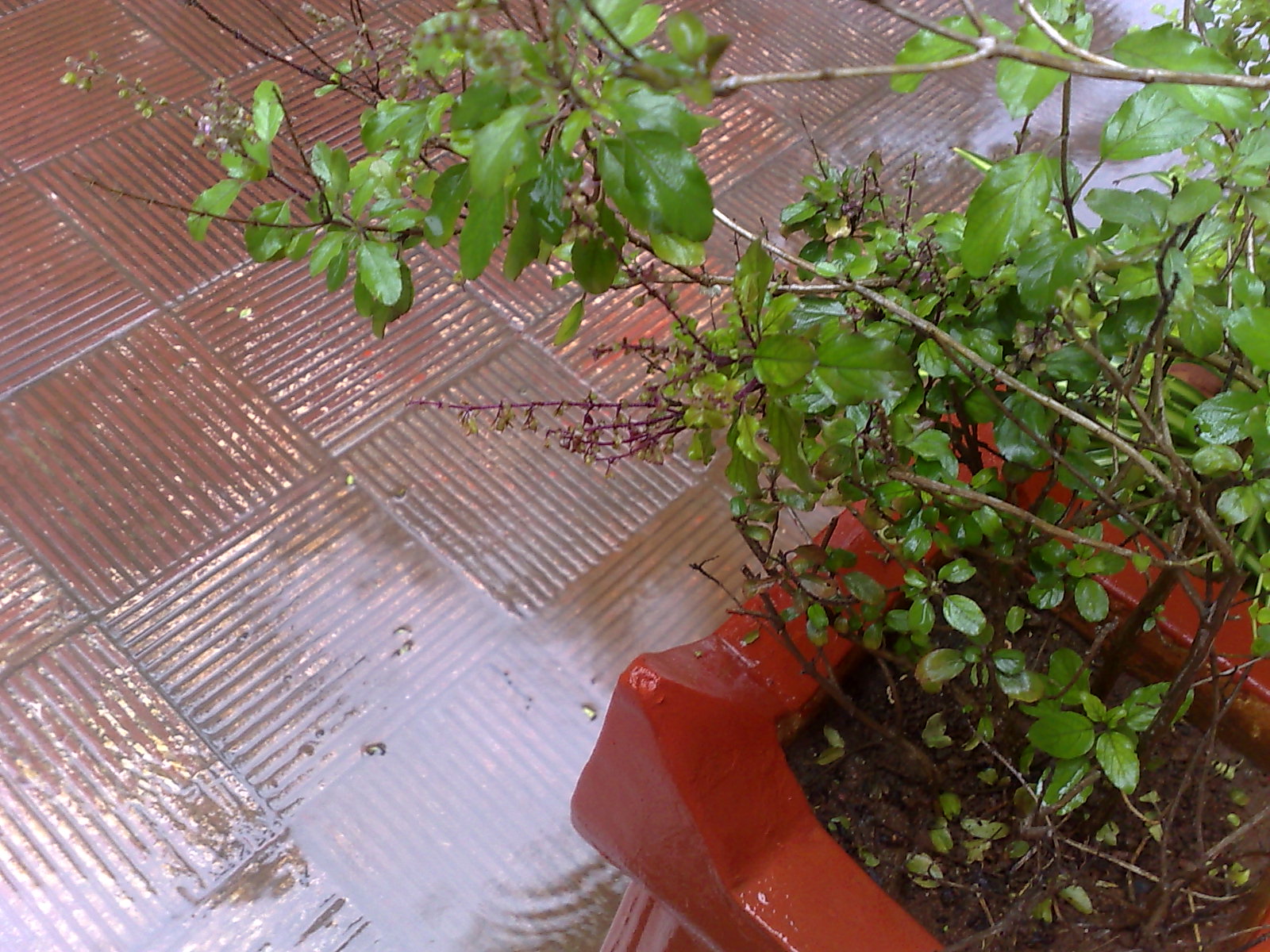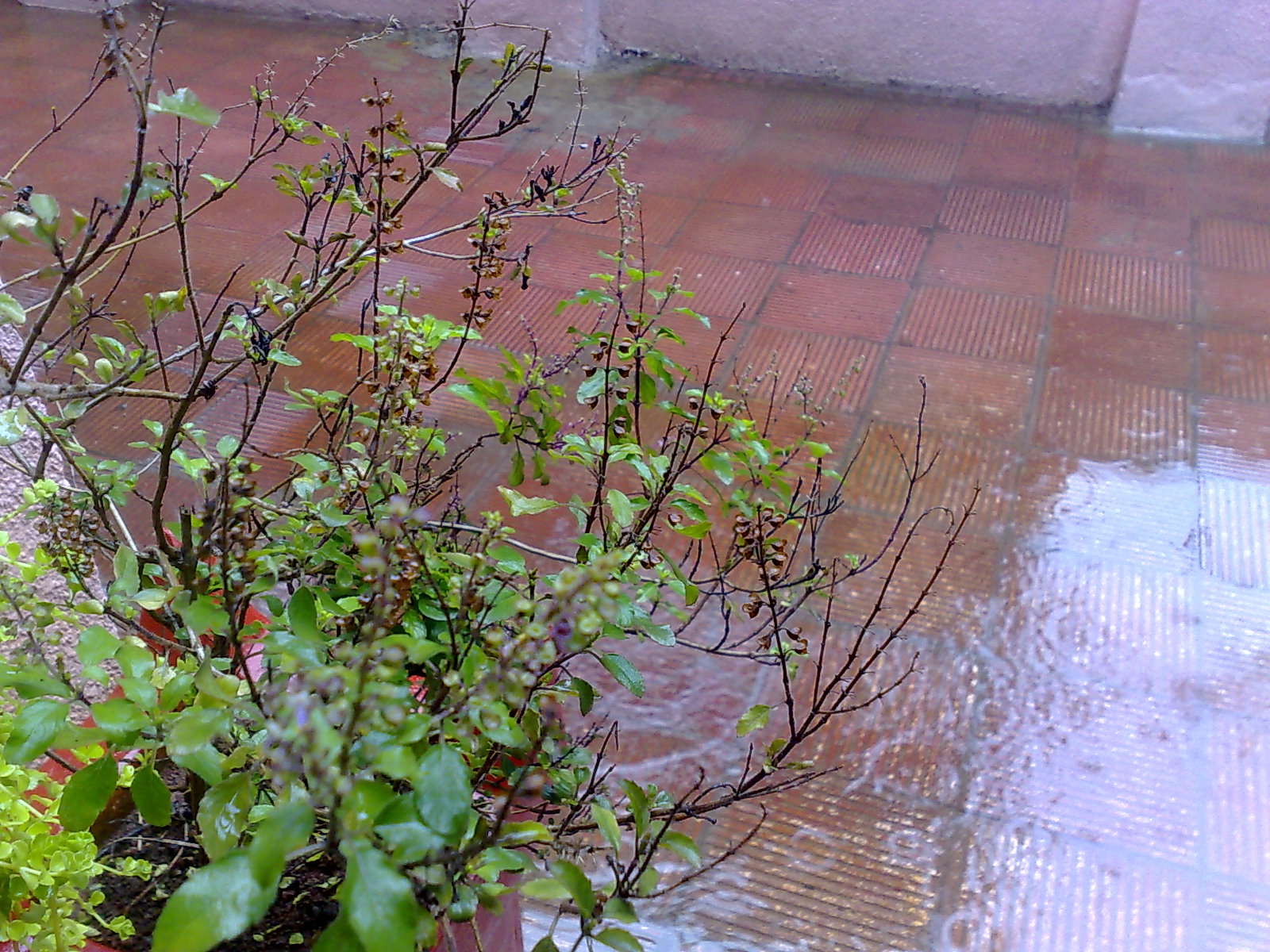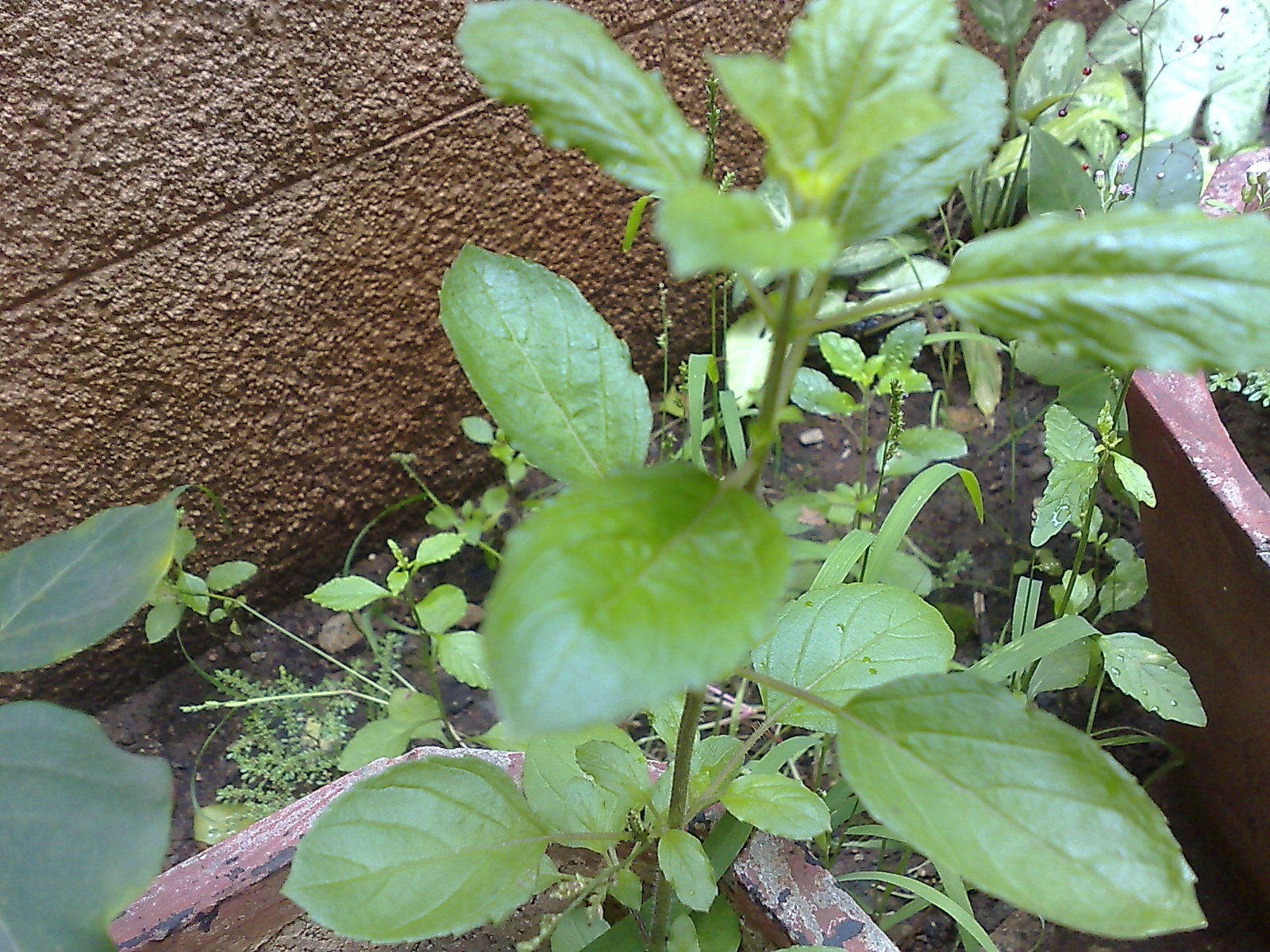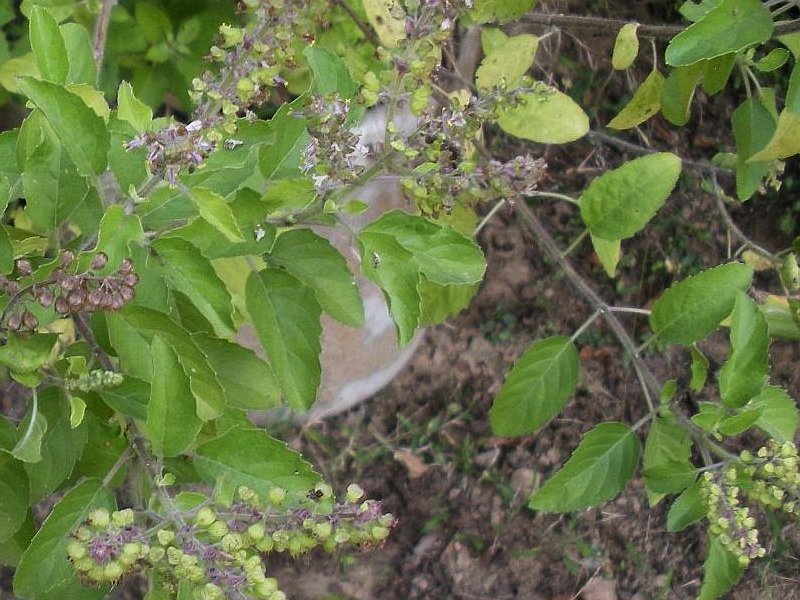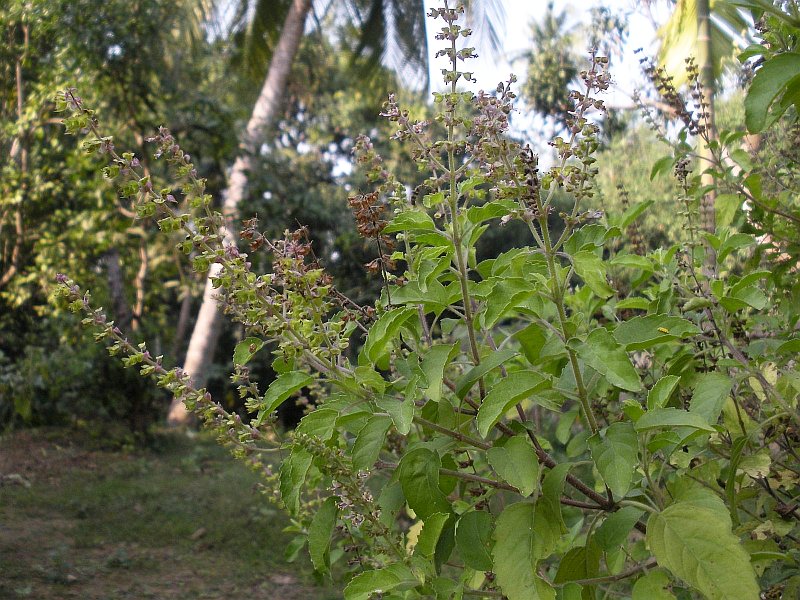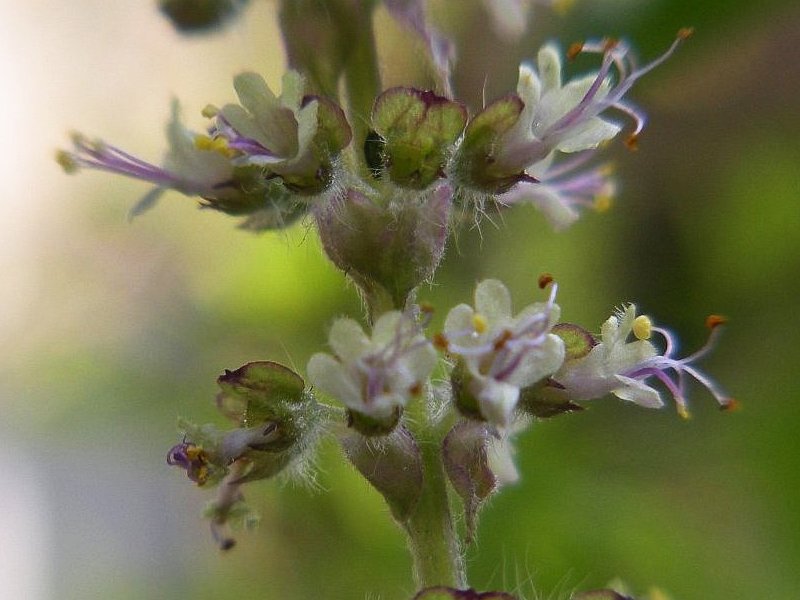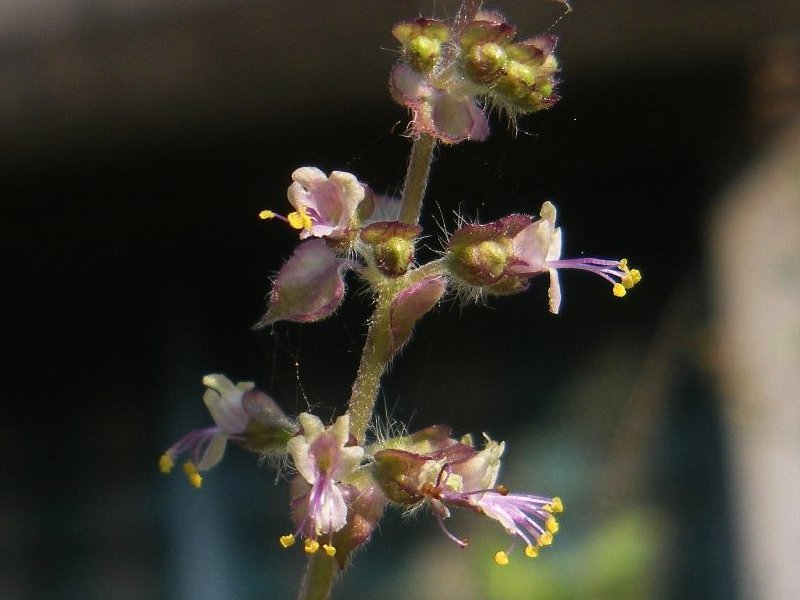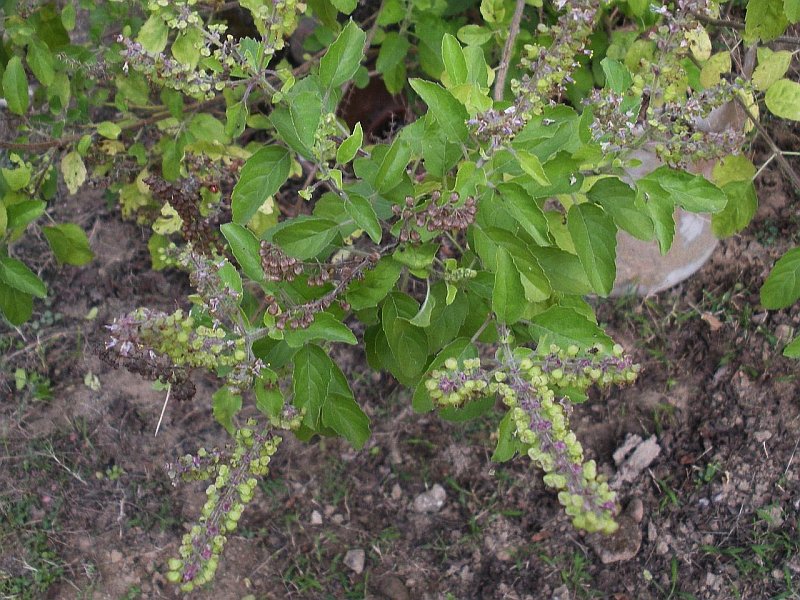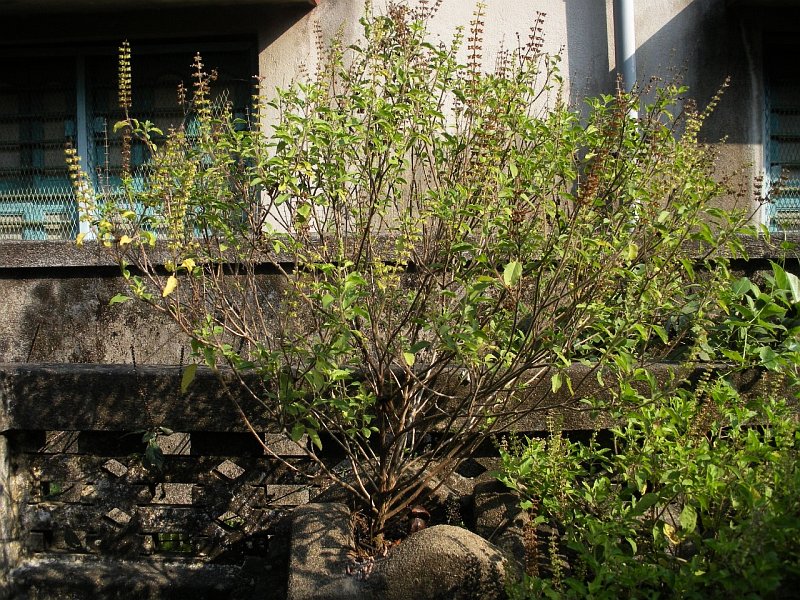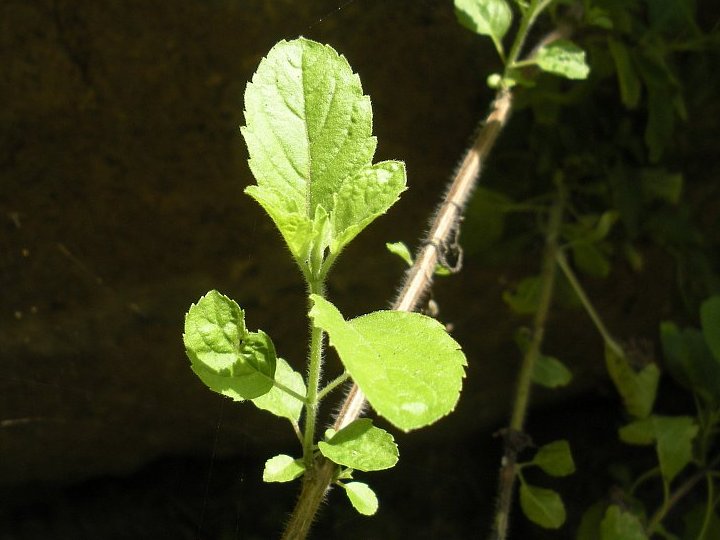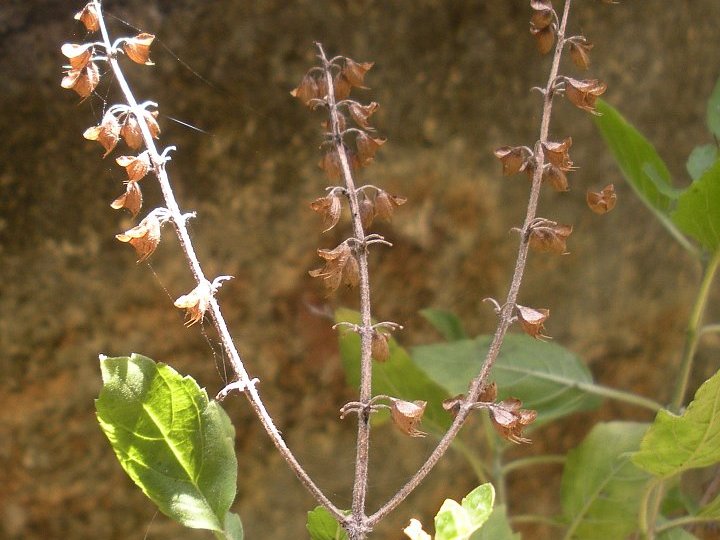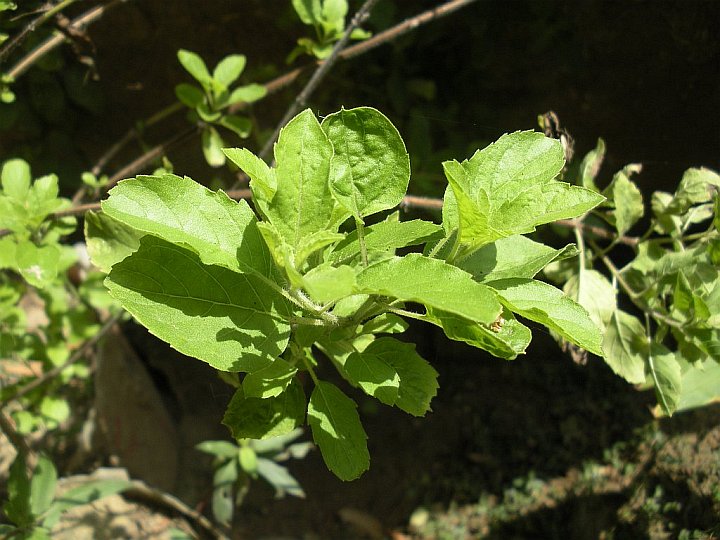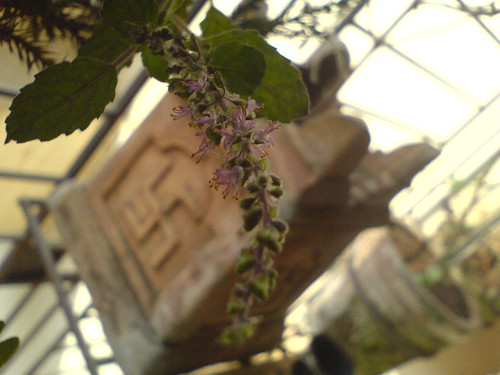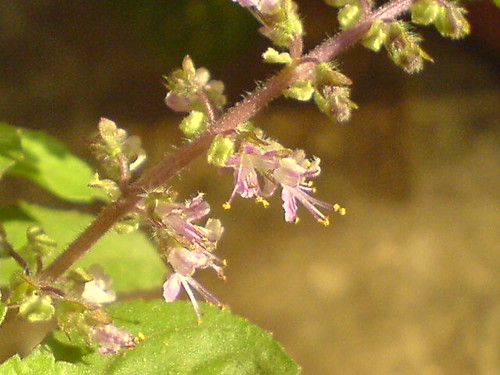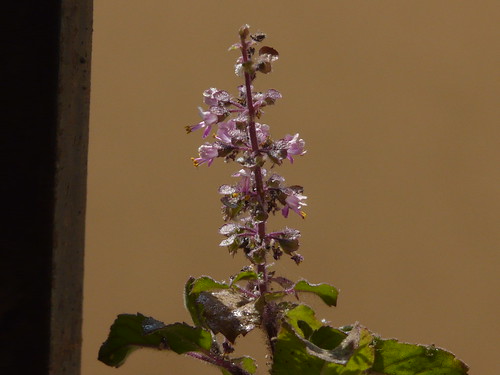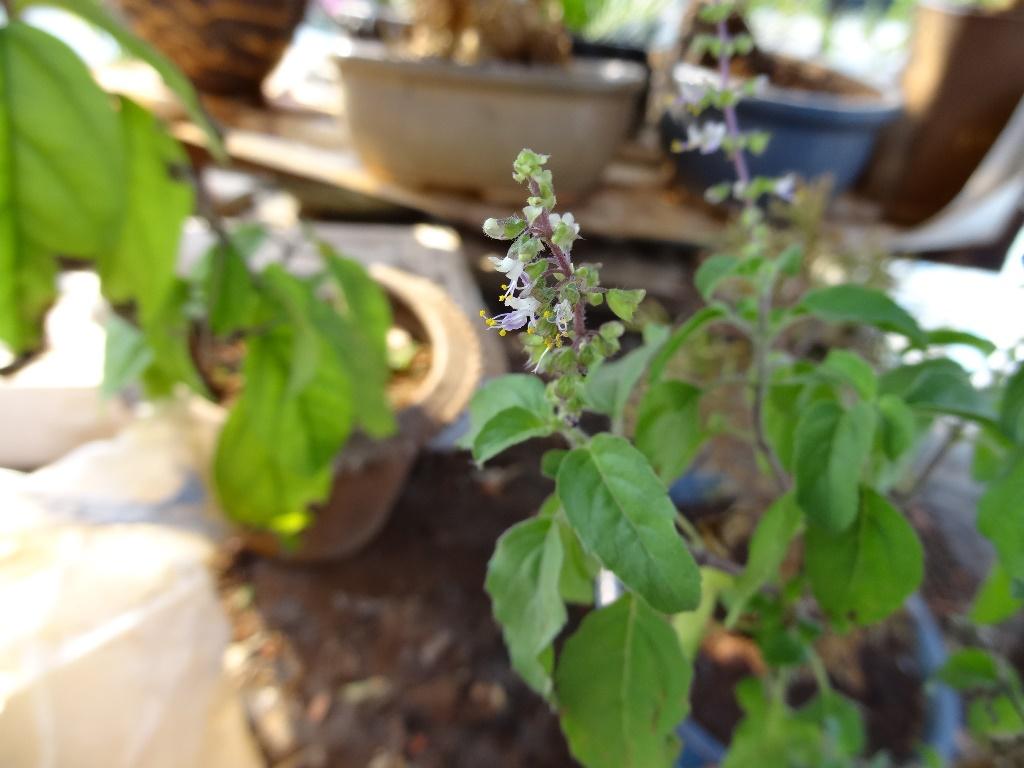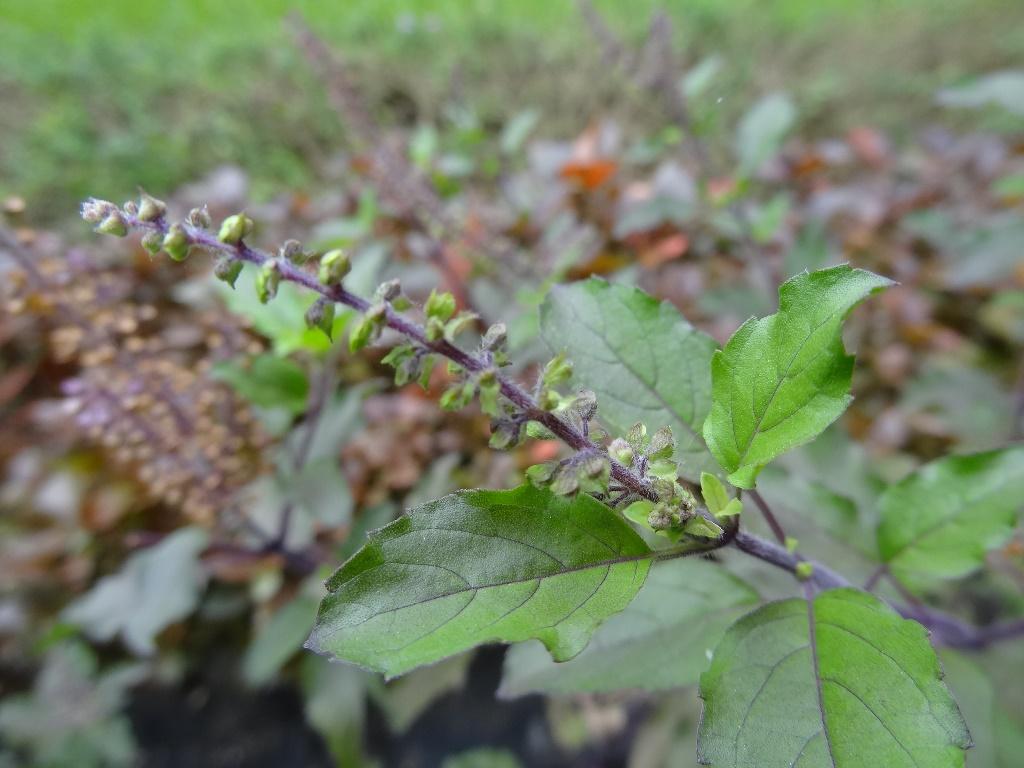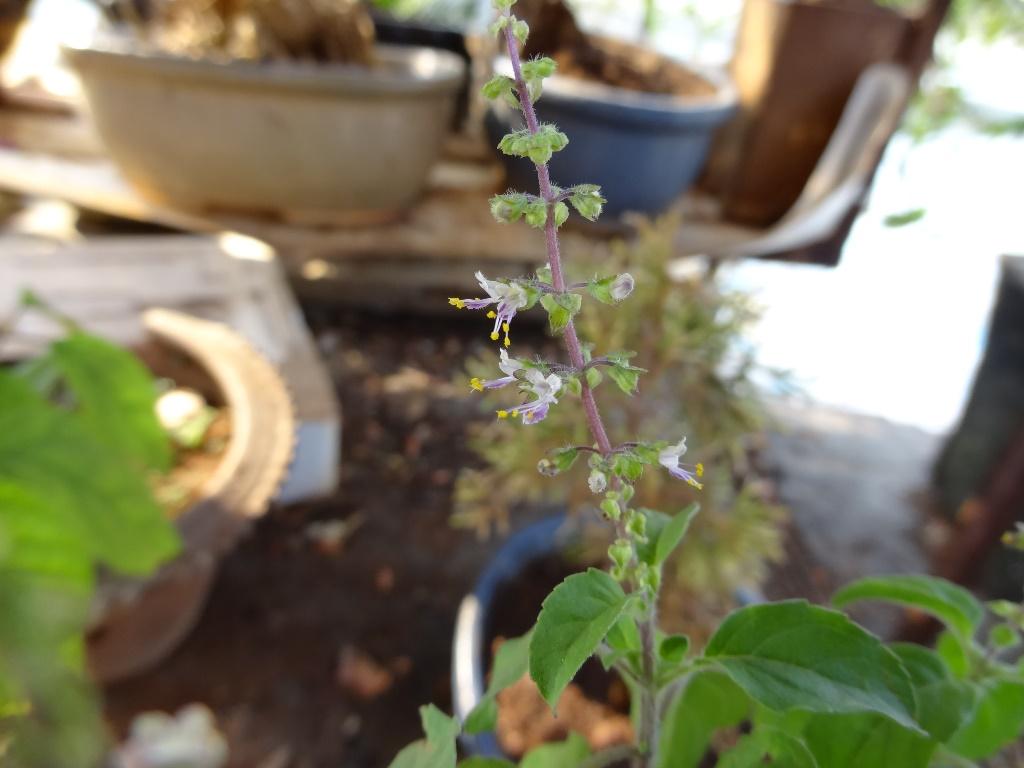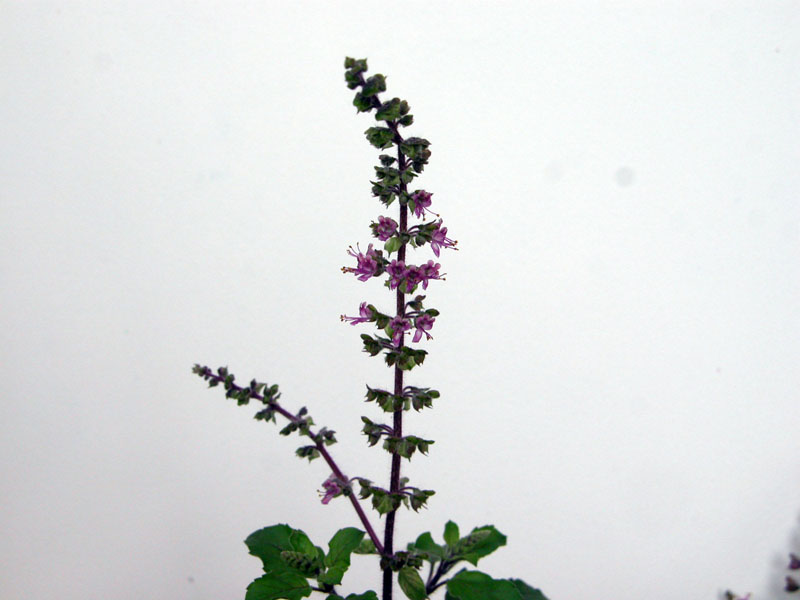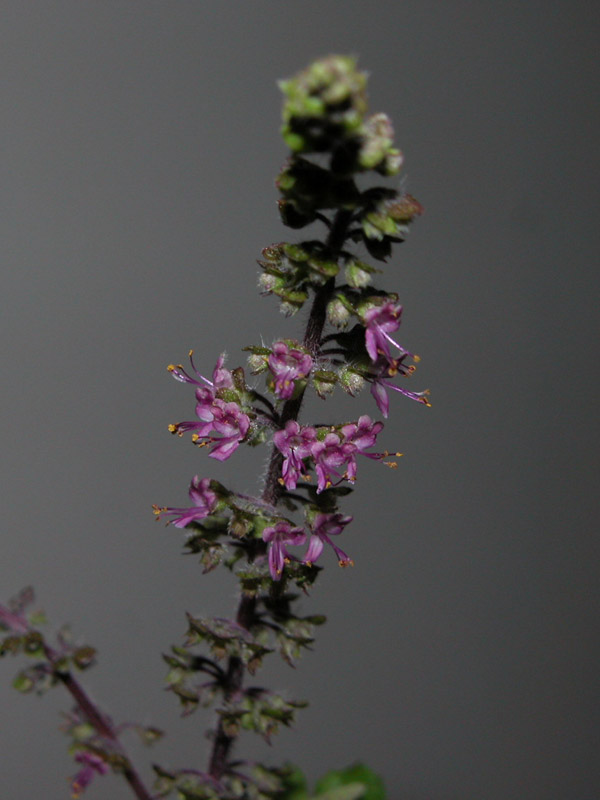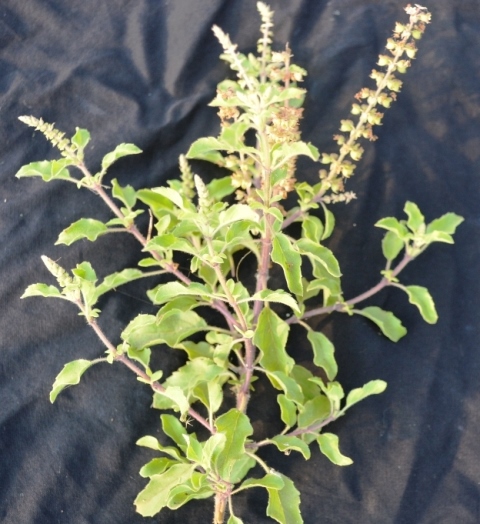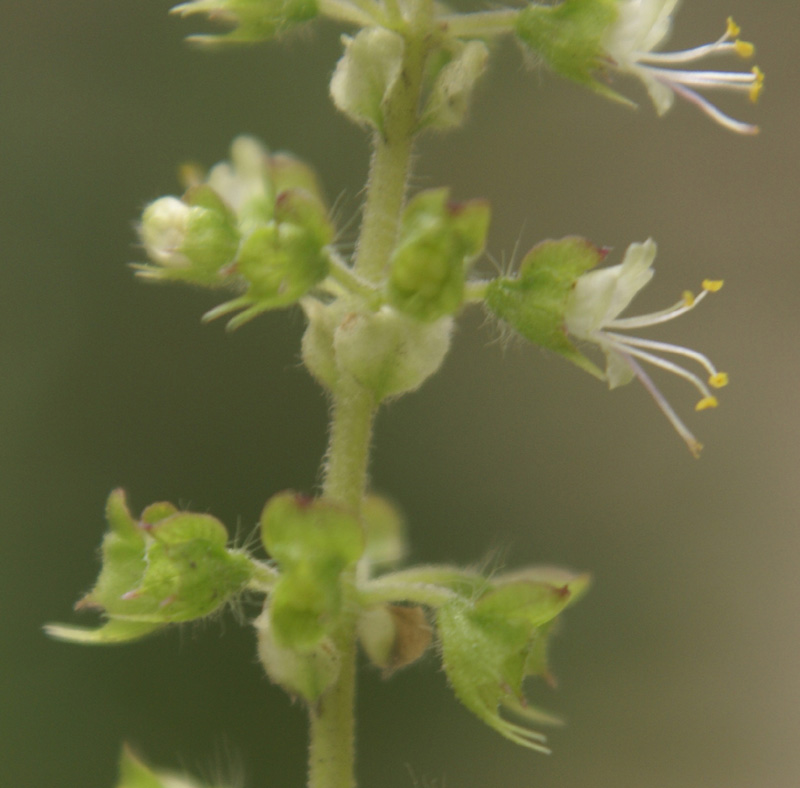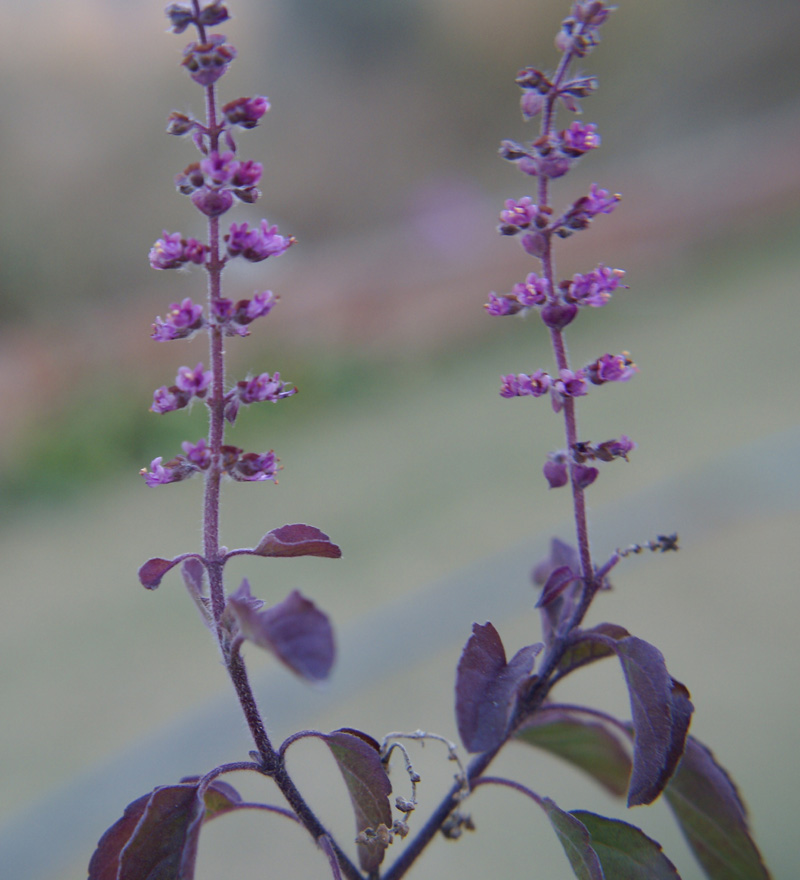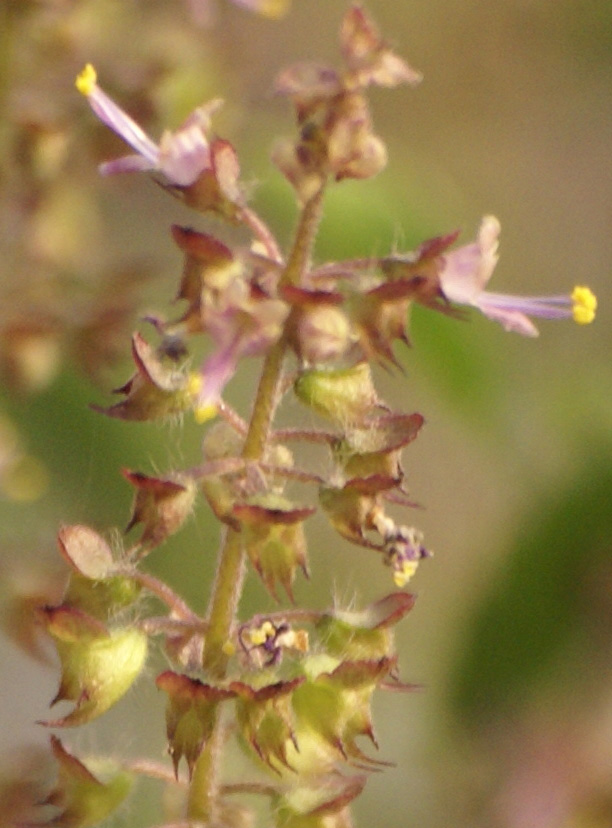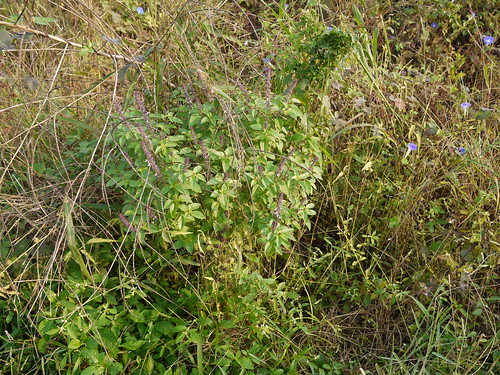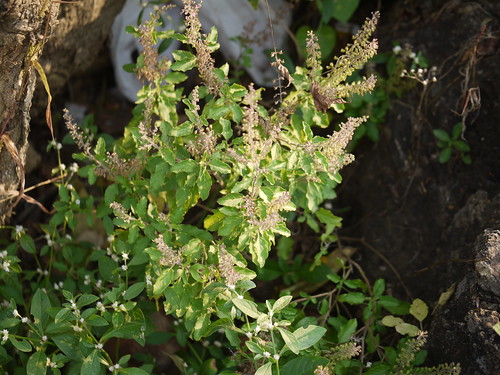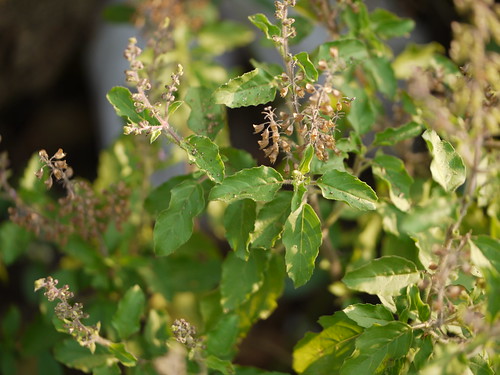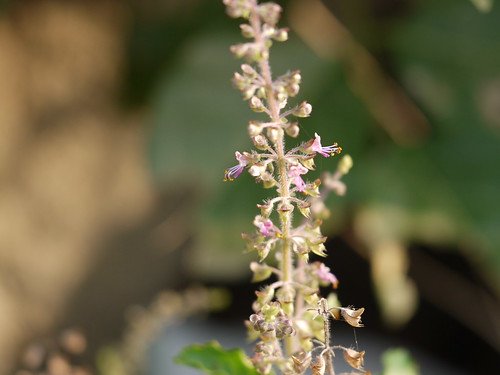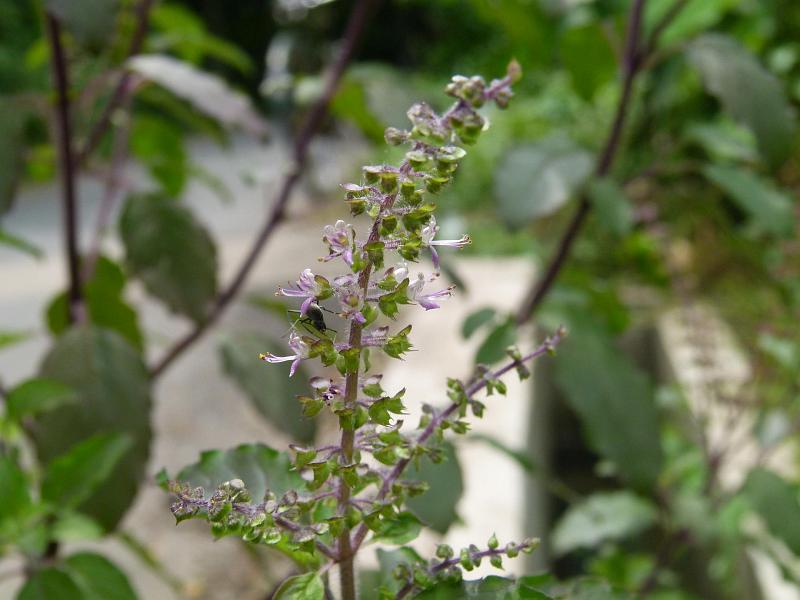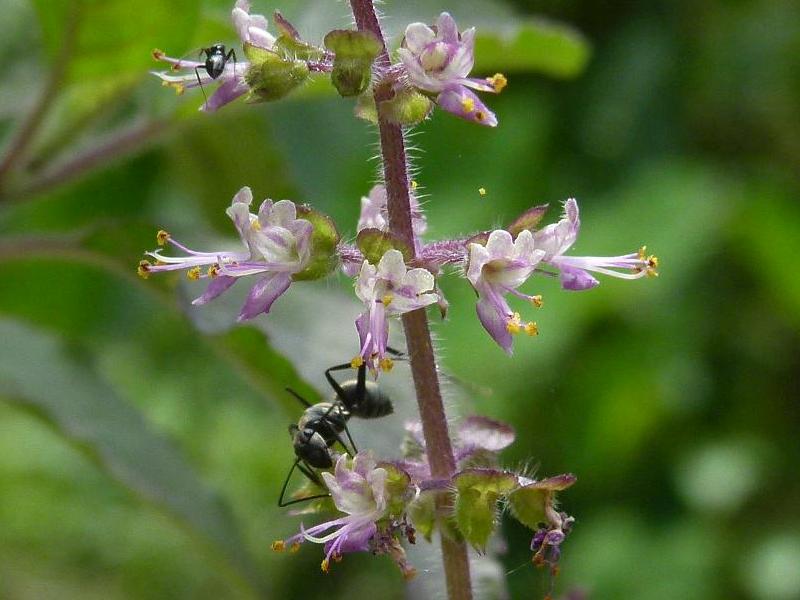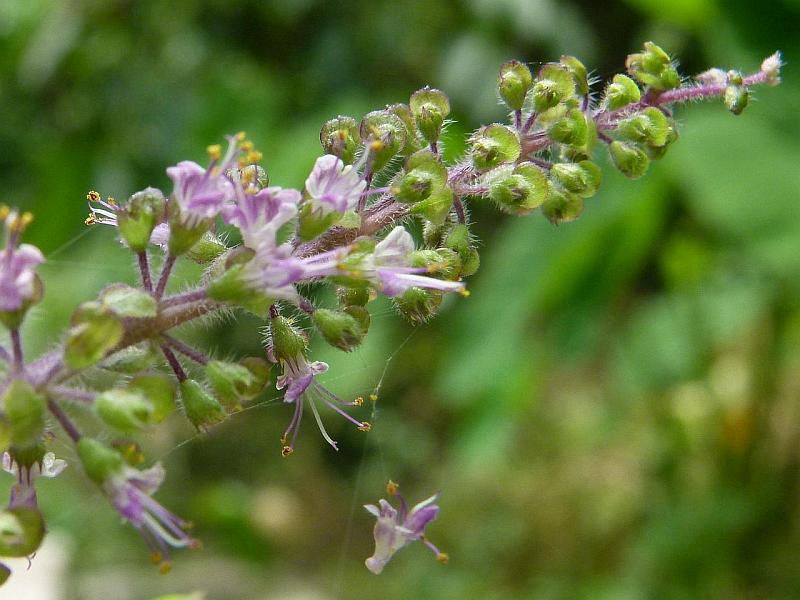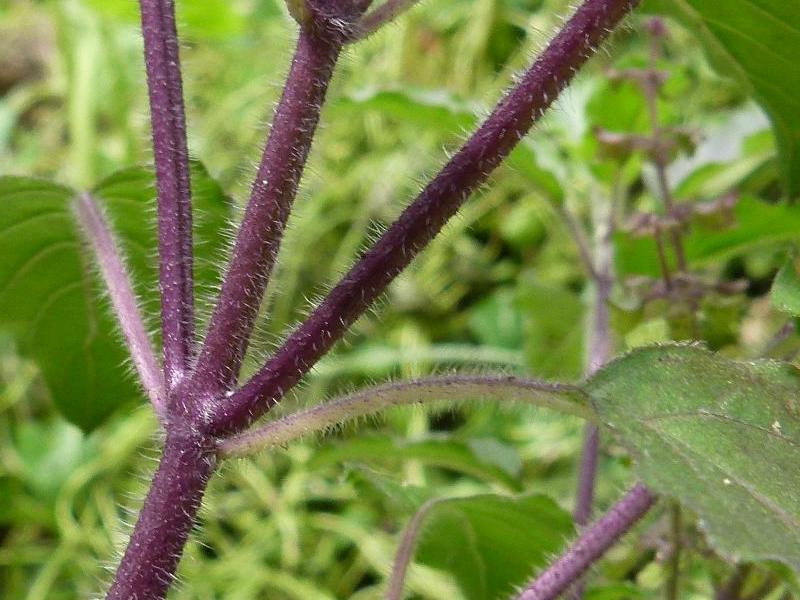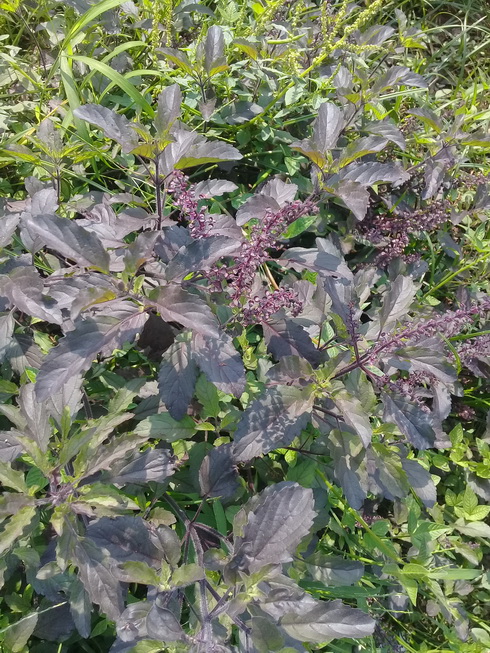|
Ocimum tenuiflorum L., Sp. Pl. 597 1753. (Syn. Geniosporum tenuiflorum (L.) Merr.; Lumnitzera tenuiflora (L.) Spreng.; Moschosma tenuiflorum (L.) Heynh.; Ocimum anisodorum F.Muell.; Ocimum caryophyllinum F.Muell.; Ocimum hirsutum Benth.; Ocimum inodorum Burm.f.; Ocimum monachorum L.; Ocimum sanctum L.; Ocimum sanctum var. angustifolium Benth.; Ocimum sanctum var. cubensis Gomes; Ocimum sanctum var. hirsutum (Benth.) Hook.f.; Ocimum scutellarioides Willd. ex Benth.; Ocimum subserratum B.Heyne ex Hook.f.; Ocimum tenuiflorum var. anisodorum (F.Muell.) Domin; Ocimum tenuiflorum f. villicaulis Domin; Ocimum tomentosum Lam.; Ocimum villosum Roxb. [Illegitimate]; Plectranthus monachorum (L.) Spreng.);
.
Maduruthala, Holy basil, Tulsi तुलसी (Hindi, Tamil, Telugu), Trittavu (Malayalam), Tulshi (Marathi);
.
The essential oil has antibacterial and mosquito repellent properties, leaves used in catarrah, expectorant, in bronchitis, malarial fevers, cutaneous diseases and ringworms;
.
My grandmother used to collect fallen tulsi seeds (manjari) and keep them in all the rooms to ward off mosquetos;
.
Complete set of Keys for Indian Species available on efi page Ocimum.
.
Although they may be confused, Leaves are usually shorter than 2.5 cm narrower than 1.5 cm in O. americanum, always longer than 2.5 cm and broader than 1.5 cm in O. basilicum. Corolla 3-5 mm long in former, 6-9 mm long in latter. fruiting calyx 4-5 mm long in former, 5-7 in latter. Both are herbs with fruiting calyx ascending or spreading, upper calyx lobe circular with wings decurrent (joined) to middle of calyx, and front two teeth of calyx quite distinct.
O. gratissimum is a shrub with wooly leaves 5-12 cm long and 1.5-6 cm broad, fruiting calyx drooping, up to 5 mm long and corolla 4.5-5 mm long. Upper calyx lobe has wings only slightly decurrent on calyx, and front two teeth very close to each other.
Calyx tube is bearded within in all above species
O. tenuiflorum (O. sanctum) has 2-4 cm long leaves, calyx glabrous within, fruiting calyx spreading, 4-5.5 mm long, corolla 3-4 mm long. upper calyx lobe abruptly acute, lower two teeth long, spine-tipped.
. efloraofindia:”For Id 03092011MR3’’ differentiate Ram tulas from Krshna tulas Pune:
I have 2 Tulsi plants at home. One is called Ram tulas and the other Krishna Tulas. I appreciate that Ram tulas is lighter and Krishna tulas is darker. Are there medicinal differences in the two? Some mythological significance
It is a holy plant Tulsi leaf is very dear to God Vishnu and more so the seeds called Manjiri in Marathi and my Grandmother would say that God Prefers one Manjiri to gold and silver or any other offering. According to my information the common tulsi plant, the Sacred basil or holy basil, botanically Ocimum tenuiflorum L. (syn: O. sanctum L.) is called Krishna tulsi. In fact two types of plants are known for this species: one with green leaves and stem is Sri Tulsi and one with purple leaves and stems as Krishna Tulsi. The essential oil has antibacterial and mosquito repellent properties, leaves used in catarrah, expectorant, in bronchitis, malarial fevers, cutaneous diseases and ringworms.
Ram tulsi (also known as ban tulsi) is Ocimum gratissimum, the shrubby tulsi, having much more stronger scent and often planted as mosquito repellent. used as relief of ear-ache, tooth-ache, also used in cough mixtures. Herb also used in aromatic baths and fumigations for rheumatism and paralysis.
A small correction. The inflorescence is called as Manjiri and not the seeds. My grandmother used to collect fallen tulsi seeds (manjari) and keep them in all the rooms to ward off mosquetos. Thats a great idea to repel mosquito in a herbal way efloraofindia:”Id 13092011MR2’’ Tulas inflorescence Pune: Good crisp flowers of Ocimum sanctum Now Ocimum tenuiflorum.
efloraofindia:”For Id 29052012MR2’’ 4 pollinators foraging Ocimum tenuiflorum at Pune: May 2012 Pune.
Found 4 pollinators foraging the small herb of Ocimum tenuiflorum (Tulas in Marathi) at my home.
The ?wasp and ?bees were seen around 11.00 am to 2.00pm followed by the butterfly and the insect in the late evening.
pic 3&4 -is it yellow jacket wasp?
Pic 6- is it Common Cerulean?
Please validate
Would appreciate your help to Id the bees and the insect too. All animals that visit the flowers may not be pollinators. Its not very strange. But those visitors like 3 & 4: Insect on flower so yes it can be pollinator. There is a term called head space. in pic no. 3, the insect, the way it enters the flower, doesnt look like it can pollinate the flower!!
6: The butterfly is not on the flower, just the calyx, hence it is looking for something else on non reproductive parts. Probably not a pollinator.
7: Too small to be a pollinator
9 & 10: again not on flowers but the persistent calyx, hence may not be pollinators.
Studies on pollinators are really interesting topic which Indians have been avoiding. There are so many endemic plants in India. Point is why they are endemic??? One of the reasons may be the limitation of pollinators. We should encourage people to work on this aspect of botany. Its very interesting and we can get lot of good information out of it. The best thing is, its a multidisciplinary subject: botany, entomology, ecology, chemistry, behaviorial ecology…. Some on take up this task please.
…………………………….
Pic 6 is Chilades pandava (Common Name: Cycad blue butterfly, Plane cupid) Fwd: efloraofindia:”For Id 29052012MR2’’ 4 pollinators foraging Ocimum tenuiflorum at Pune: Apologies for not having replied earlier. Thought I am usually happy to assist in identifying any photograph, was reluctant to do so here as i did not find the photographs particularly stimulating. In common parlance – the effort that goes into identifying a photograph should be commensurate with the effort that goes into taking it and I don’t think the right balance was acheived here. However, since you have been persistent – they are :
– Yellow jackets are aggressive paper wasps that belong to the Family Vespidae.
– Plains Cupid butterfly.
– Pentatomid Bug possibly the nymph of a Stink Bug.
– Polistes sp. also a species of Paper Wasp.
Ocimum sp. 2 Hooghly 19-12-12 sk1: I have been told that this is TULSI in Bengali.
Species : UNKNOWN
H & H : herb, 1.5 ft to 3 ft
Date : 18/12/12
Place : Hooghly Efi link of Tulsi: Yes it is Ocimum tenuiflorum, Are O. tenuiflorum and O.sanctum synonyms. If not how do you differentiate between the two? Yes …, they are synonyms, with O. tenuifolium being the correct name.. This is TULSI, without any prefix, in Bengali and this is also from my own yard. Please confirm the ID.
Species : Ocimum sanctum ?
Type : Home yard, also in the wild in villages
Leaf blade : 3 cm X 2 cm
Inflorescence size : 7 cm
Plant height: 2 ft.
Date : 21/Feb/2012, 9.57 A.M.
Place : Nalikul (Hooghly), West Bengal Yes to me also O sanctum Thank you … for confirming and informing the new name of the species. . Sorting Ocimum species : 9 posts by 5 authors.
It may look strange to you but I feel Ocimum is another genus which needs careful relook at our databases, especially Flowers of India.
Although there are lots of cultivars in the genus, but I think we can set our specimens in order. I request members to kindly observe carefully their photographs/specimens, photographs of Indiantreepix and Flowers of India website, and compare with several authentic photographs with the net. While doing so kindly keep following features in mind:
Although they may be confused, Leaves are usually shorter than 2.5 cm narrower than 1.5 cm in O. americanum, always longer than 2.5 cm and broader than 1.5 cm in O. basilicum. Corolla 3-5 mm long in former, 6-9 mm long in latter. fruiting calyx 4-5 mm long in former, 5-7 in latter. Both are herbs with fruiting calyx ascending or spreading, upper calyx lobe circular with wings decurrent (joined) to middle of calyx, and front two teeth of calyx quite distinct.
O. gratissimum is a shrub with wooly leaves 5-12 cm long and 1.5-6 cm broad, fruiting calyx drooping, up to 5 mm long and corolla 4.5-5 mm long. Upper calyx lobe has wings only slightly decurrent on calyx, and front two teeth very close to each other.
Calyx tube is bearded within in all above species
O. tenuiflorum (O. sanctum) has 2-4 cm long leaves, calyx glabrous within, fruiting calyx spreading, 4-5.5 mm long, corolla 3-4 mm long. upper calyx lobe abruptly acute, lower two teeth long, spine-tipped.
O. kilimandscharicum is a shrub with smell of camphor (our database has thread on this species but no photograph). I have yet to find authentic description of this species. Colleagues may please help. I wonder how i missed … this informative mail on Ocimum. What a coincidence sir ji, we also have thought about in the similar line and have done something (very small but) on this complex group. ‘Tulsi‘ is another theme in the series of FRLHT’s publications, and we have prepared a poster, as an educational material for the students, scholars, foresters etc. I understand that only 5 species of Ocimum occur in India. Other details and photographs of these can be seen in the attached poster. I welcome your comments/suggestions. I had few snaps of Ocimum. Thought of sharing with you all. Photographed at Nagpur. This, i think, Ocimum basilicum var. purpurascens. Any way it is O. basilicum, but dont know the variety Yes … It is O. basilicum var. purpurascens Also thank you for the Ocimum poster. If you have access, could you manage close up photographs of flower, fruiting calyx and leaves of O. americanum and O. killimandsharicum. I have uploaded these on the group for other three species recently. These pictures (Ocimum americanum & O. kilimandscharicum) were taken by my colleague … Hope these will be useful. SYMBIOSIS : 450 : Attachments (1). 1 post by 1 author.
Attaching an image of a Lime Blue butterfly on the flowers of Ocimum sanctum. SYMBIOSIS : 455 : Attachments (1). 3 posts by 2 authors.
Attaching an image of a Psyche butterfly on the flowers of Ocimum sanctum (TULSI). Fwd: [itpmods:8256] information about Ocimum tenuiflorum : 3 posts by 1 author. 3 images.
I am …, from the University of Venice in Italy.
My main field of research is history of religions in East Asia, but I am also very much interested in the history of religions in India and the Indian Subcontinent.
In addition to that I have a very strong passion for horticulture which often draws me towards botany, although my knowledge in the field is quite limited.
I am writing you because I was wondering if you could help me understand what are the varieties (and eventual cultivars) of Ocimum tenuiflorum (Ocimum sanctum) and of Ocimum gratissimum.
This especially in relation to the Tulasī worshipped in Vaiṣṇavism since although there are three main types, i.e. Rāma/Śrī, Kṛṣṇā and Vana, I am not exactly sure to which plants exactly they refer to (I believe Rāma/Śrī Tulasī and Kṛṣṇā Tulasī are Ocimum tenuiflorum, but don’t know which varieties or cultivars and Vana Tulasī is Ocimum gratissimum, but again, I don’t know which type specifically).
Furthermore I would like to ask if you could help me identify a plant that a friend of mine has brought me back from Northern India. I am in fact trying to grow Indian plants in order to show their beauty and virtues to Italian people here in the Euganean Hills, and I am therefore trying to find varieties that can survive well in the cooler Italian weather.
He actually brought back the seeds and said it is an Himalayan variety of the sacred Tulasī worshiped in Indian courtyards, but more resistant to colder climates.
It is growing quite well but it looks a bit different from the sacred Tulasī plants I have seen online and the ones kept in a greenhouse at the local Vaiṣṇava community, since they have narrower leaves with darker veins. The smell is also different since the plant I am growing is more sweet/minty compared to the ones I have seen in the greenhouse.
Could you help me identify it? Let me share with you that that Rama tulasi is Ocimum gratissimum L while as Sri tulsi and krsna tulsi are the same but the species are different. O.sanctum also known as sacred tulsi and O. tenuiflorum with green leaves is sri tulusi and the plants with purpule leaves are krsna tulsi and the sweet species you are growing is Ocimum basilicum L. The herb image found here is Ocimum tenuiflorum – green variety. Purple and purple-green intermediate strains available in O. tenuiflorum, but all will give similar aroma. Ocimum gratissimum is a taller herb, leaves also larger in size. In tamilnadu O.gratissimum is called Ram tulasi. The purple strain of O. tenuiflorum is called Krishna tulasi. Attachments (3). Lamiaceae (incl. Verbenaceae) Fortnight :: Ocimum tenuiflorum :: Thane :: DVMAY36/36 : 1 post by 1 author. 6 images.
Ocimum tenuiflorum L.
at home between December 25, 2006 and November 15, 2008
Lamiaceae (incl. Verbenaceae) Fortnight :: Lamiaceae ::Ocimum sanctum :: SMPMAY11/11 : 2 posts by 2 authors. 1 image.
Ocimum sanctum Lamiaceae (incl. Verbenaceae) Fortnight :: Lamiaceae :: Ocimum sanctum :: Mumbai :: ARKMAY-45/45 : 1 post by 1 author. Attachments (4)Attached are pictures of Ocimum sanctum (Tulsi) captured at Mumbai in October 2012. Lamiaceae (incl. Verbenaceae) Fortnight :: Lamiaceae ::Ocimum ??:: SMPMAY13/13 : 4 posts by 2 authors. 2 image.
Ocimum for ID I doubt it is Ocimum. At the same based on this photograph it is difficult to say even genus Yes, it is Ocimum, Ocimum tenuiflorum L., Syn. O.sanctum. Lamiaceae fortnight 03 : 1 post by 1 author. Attachments (1)
Ocimum tenuiflorum L.,
sacred, medicinal herb, essential oil is used as a medicine, perfume, tea of leaf good for cough and arthritis.
Lamiaceae (incl. Verbenaceae) Fortnight: Lamiaceae Ocimum tenuiflorum from Delhi and Gurgaon–GSMAY81/84 : 1 post by 1 author. Attachments (5) . Ocimum tenuiflorum (syn: O. sanctum), the Tulsi plant, sacred as well as medicinal. Photographed from Delhi and Gurgaon
Lamiaceae (incl. Verbenaceae) Fortnight :: FOR VALIDATION :: Ocimum tenuiflorum :: DVMAY110/110 : 3 posts by 2 authors. 4 images. Ocimum ¿ tenuiflorum ?
I get a feeling this Ocimum growing wild (or having escaped) must be tenuiflorum. Please validate.
at Vaghbil on October 30, 2010 I think yes … Thank you very much … I needed a seconding thought. August2015sk02/02 — Ocimum sanctum L.? : 10 posts by 3 authors. Attachments (8)
Recorded this herb on rural roadside, but possibly planted, on the day before yesterday (08-08-2015).
The height is around 2.5 ft. I have no other stats.
Based on images I have with me I find it difficult to identify the species with certainty.
Since both lower and lateral lips of calyx are spinescent I think this is O. sanctum L. Please correct me if I am wrong. Yes it is Ocimum tenuiflorum syn. O. sanctum; there are 2 varieties one with purplish stems leaves and flowers, another with green stems leaves and white flowers. the purplish variety is more hairy than the other. From the photos it seems it is of common basil only and the name Ocimum tenuiflorum L. (syn: Ocimum sanctum L.) is correct. Ocimum tenuiflorum (= O. sanctum) pink strain – regular Tulasi It’s interesting to note that unlike FoC’s description the bracts here are not sessile, not cordate. Ocimum of Indonesia 1 : 4 posts by 2 authors. Attachments (2)
Could you help me to confirm the following pictures please. Is it Ocimum sanctum? Identification is correct as O. tenuiflorum. Kerala, 900m, january 2019.
Seems to be Ocimum tenuiflorum, purplish variety. Must be a cultivar. Thank you.
04122014EPT39 : 3 posts by 3 authors. Attachments (7)- around 450 kb each.
Ocimum tenuiflorum (green variety – Rama thulsi) ?? for confirmation
Location : Chennai outskirts
Date :03.12.2019
Elevation : 23 mts.
Habitat :Urban garden
Habit : cultivated short herbal plant
just the nomenclature comment:
Rama tulasi is Ocimum sanctum 02122019EPT38 : 16 posts by 5 authors. Attachments (3)- around 500 kb each.
presenting for confirmation
Ocimum tenuiflorum (purple variety Krishna tulsi, black tulsi, Karum tulsi in Tamil) Location : Chennai outskirts Date :02.09.2019
Elevation : 23 mts.
Habitat :Urban home garden
Habit : Short herbal plant cultivated
For me the ID is correct : Ocimum tenuiflorum (syn. O. sanctum L.). … is correct. this looks like Krishna tulasi But i must also point out that Ocimum tenuiflorum and O. sanctum are not synonyms.
if you grow them, you begin to notice the differences
ALthough i should have said that Wikipedia thinks they are synonyms but in my experience they look behave and taste very different esp. after several years of self seeding in the same gardens… and self seed differently please elaborate … which is Ocimum tenuiflorum and which is O. sanctum …… As for ”Krishna” and ”Gaura” varieties, other than color, what other differences you have noticed ?
At times it seems ”Krishna” is robust, and has a bit larger flowers, and longer, bit less dense spike.
But then, ”Gaura” shows lot of variation in leaf size and texture.
Probably an intermediate form too…. leaves green, stem reddish… this I have to be on look out for inflorescence color … I do not remember or have not noticed. i am not familiar with “gaura” Thanks. I have mentioned the synonym based on this link: http://www.theplantlist.org/tpl/record/kew-137105 the 1.1. version of the plant list which is the latest. The experts may advise me as to where I should check for the latest names as the 1.1. version has not been revised. you are right, there is lot of confusion even in my search.
i was just talking about my experience from planting these plants and using for puja and eating. Rama (labelled Ocimum sanctum) and Krishna tulasi (labelled O. tenuiflorum) plants. labelled when purchased at the Agri-Horticulture Garden Kolkata.
I keep reading the pharmacognosy papers from ayurvedic folks and they give very confusing nomenclature and ideas. just like this paper. please try to make sense of this
==
More heartening news is at least to my mind that these two plants should be separated by their chemical constituents and so by inference… in their genetic make up.
One molecular biology testing study from 2015 is suggesting at least that these may be typed as two separate subtypes. because they found that the Krishna tulsi had different up and down regulated genes compared to Rama tulsi. I quote ” The differentially expressed genes found in the transcriptomes of both the Tulsi subtypes were analysed.
We observe a substantial number of genes up-regulated and down-regulated in Krishna Tulsi, compared to Rama Tulsi.” end quote.
through out the results one finds other difference in the two subtypes
URL for this paper is: https://bmcplantbiol.biomedcentral.com/articles/
==
to my mind this is progress of sorting these two plants. You have made an excellent analysis, rather well researched information. Your observations are very relevant and need to be taken not of, by the taxonomists. I was of the opinion that that the purple variety (Krishna thulasi = karumthulasi) and the green variety (Rama thulsi) are both O.tenuiflorum Krishnaa and Gaura (meaning a lady of fair skin) are the names given by village folk for Purple and Green Tulsi respectively … and Tulsi is considered as avatar of Goddess Lakshmi, hence the feminine names. For record, Ram and Krishna, both are described as dark skinned. Here The Plant List is based on WCSP (one of the most authoritative list made by Kew, but only for selected families)
Current list of WCSP be seen here.
SK 2406 21 January 2020 : 8 posts by 3 authors. 5 images- 6 to 7 mb each. Date: 07 December 2019
Elevation: MSL
Habitat: Cultivated
Ocimum ? Planted as garden herb in a hotel.
Ocimum sanctum Salvia ? : 8 posts by 4 authors. Attachments (2)- around 900 kb Ocimum sp.! Seems like Ocimum basilicum And Ocimum tenuiflorum ? Seems very close… Yes, … Ocimum tenuiflorum syn O.sanctum – Krishna tulasi Shrub id from BD_SM_1203 6 : 6 posts by 2 authors. Attachments (1) Pl. check comparative images at Ocimum Ocimum species.
I have this plant. This is krishna tulasi. Ocimum tenuiflorum syn. O.sanctum. Image quality is very poor for ID, however … has ID. . Ocimum tenuiflorum L. :: Waghbil, Thane, Maharashtra :: Nov 15, 2008 · JUN23 DV63: 3 images. .
Lamiacae: Ocimum tenuiflorum: 2 high res. images.
synonyms: Ocimum sanctum L., Geniosporum tenuiflorum (L.) Merr. location/date: (1) Tropical Forest Research Institute, Jabalpur, Madhya Pradesh, October 1994; (2: black background): Chotannahalli, Tumkur Dist., Karnataka, July 1997 . |
Ocimum tenuiflorum
Updated on December 24, 2024

